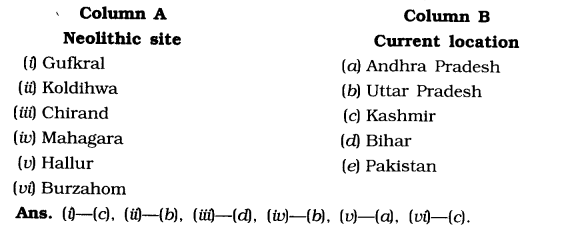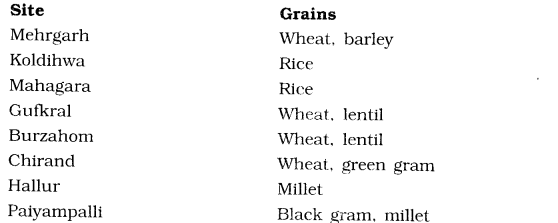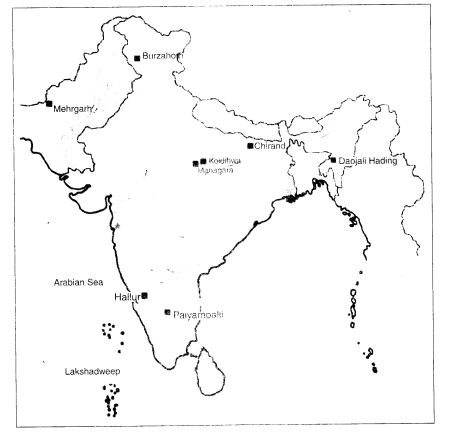NCERT Solutions for Class 6th Social Science History Chapter 3 From Gathering to Growing Food
1. Why do people who grow crops have to stay in the same place for a long time?
Answer:
- People who grow crops have to stay in the same place for a long time to look after plants-protecting them from birds, animals and their other fellows so that they could grow and crops or seeds could-ripen safely.
- Settled life is useful and essential to lead a civilized life.
- People grow crops to meet their daily food and some other needs.
2. Look at the table on page 25 of the textbook/ If Neinuo wanted to eat rice, which are the places she would have visited?
Answer:
Neinuo would have visited these places if she wanted to eat rice:
(i) Koldihwa in present-day Uttar Pradesh, and (ii) Mahagara in present-day Uttar Pradesh.
3. Why do archaeologists think that many people who lived in Mehrgarh were hunters to start with and that herding became more important later?
Answer:
On excavation, archaeologists have found bones of wild animals in the lowermost levels. On upper levels, they found cattle bones. This means that hunting wild animals was important much before herding was.
4. State whether true or false?
(a) Millets have been found at Hallur.
(b) People in Burzahom lived in rectangular houses.
(c) Chirand is a site in Kashmir.
(d) Jadeite, found in Daojali Hading, may have been brought from China
Answer:
(a) True, (b) False, (c) False, (d) True.
5. List three ways in which the lives of farmers and herders would have been different from that of hunter-gatherers.
Answer:
The lives of farmers and herders had been different in the following ways:
- They started leading a settled life instead of a nomadic life, like that of hunter-gatherers.
- They became food producers instead of food gatherers. The domestication of plants and animals became part and parcel of the people of the Neolithic stage.
- Different types of houses were built by farmers and herders. They used tools of different forms from the earlier Palaeolithic stage people. These include tools that were polished to give a fine cutting edge and mortars and pestles used for grinding grain and other plant produce.
- Generally, farmers ate cooked and well-prepared foods, while on the other hand hunter-gatherers ate uncooked and raw food.
6. Make a list of all the animals mentioned in the table on page 25 of the textbook. For each one, describe what they may have been used for.
Answer:
- Sheep might have been used for meat, milk, and wool.
- Goat might have been used for meat and milk.
- Buffalo for meat and milk.
- Ox for drawing cart, chariot, and plough.
- Pig for meat.
- Dog was domesticated for safety and taking his help in hunting some of the wild animals.
- Other animals like horse, ox, camel, donkey, etc., were called packed animals because they were used for carrying load/carts with people.
7. List the cereals that you eat.
Answer:
Some cereals eaten by us are listed below :
- Wheat
- Rice
- Maize
- Millets
- Barley
- Lentil
- Grains.
8. Do you grow the cereals you have listed in answer no. 7? If yes, draw a chart to show the stages in growing them. If not, draw a chart to show how these cereals reach you from the farmers who grow them
Answer:
I. Yes, we live in a village and we grow some of the cereals.
Chart showing the stages in growing:
- We prepare the ground.
- We sow the seeds.
- We look after the growing plants.
- We water them by a tube-well.
- We harvest the grain.
- We thresh and separate husk.
- We grind some grain, such as wheat and barley.
II. We live in a big city. We do not grow grain. We get the grains indirectly from the farmers.
- Farmers bring their produce to market.
- The grain traders buy cereals.
- We as customers go and purchase cereals.
I. Multiple Choice Questions
Choose the correct option to complete the statements given below:
(i) The first animal to be tamed was ………………..
(a)the goat as we know today
(b) the dog as we know today
(c) the dog’s wild ancestor
(d) the goat’s wild ancestor.
(ii) Which of these Is the correct order of what early man did?
(a) hunter → gatherers skilled → gatherers → herders
(b) herders → skilled → gatherers → hunter→ gatherers
(c) skilled-gatherers → herders → hunter → gatherers
(d) skilled-gatherers → hunter → gatherers → herders.
(iii) Which was not a way of storing grains in the early days?
(a) boxes
(b) woven baskets
(c) clay pots
(d) pits in the ground.
(iv) Grains like wheat and barley have been found in ……………………
(a) Koldihwa
(b) Mahagara
(c) Mehrgarh
(d) Hallur.
(v) A site in present-day Andhra Pradesh is …………………
(a) Hallur
(b) Mahagara
(c) Mehrgarh
(d) Burzahom.
(vi) Pit-houses were made in ……………….
(a) Burzahom
(b) Mehrgarh
(c) Mahagara
(d) Hallur.
(vii) Archaeologists have found levels having ………………..
A. Bones of wild animals
B. Cattle bones
C. Bones of sheep and goat
What order do these levels indicate of what happened first and what happened later?
(a) A B C
(b) A C B
(c) C B A
(d) B C A.
(viii) The dead people in Mehrgarh were buried with ………………….
(a) Cows
(b) Buffaloes
(c) Goats
(d) Dogs.
Answer: (i)—(c), (ii)—(d), (iii)—(a), (iv )—(c), (v)—(a), (vi)—(a), (vii)—(b), (viii)—(c).
II. Fill in the Blanks
Fill in the blanks with appropriate words to complete each sentence:
- Jadeite is a…………, probably brought from China.
- Ancient wood that has hardened into stone is called………………………..
- Bolan Pass is an important route into ……………….
- Remains of square or rectangular houses have been found in ………..
- ……… and ………. lived in groups called tribes.
- Rice requires ……….. water than wheat and barley, (more/less)
- Grain was used as ………….., ………, and ………….
- Animals were a source of……………. and meat.
Answer:
- stone
- fossil wood
- Iran
- Mehrgarh
- Farmers, herders
- more
- seed, food, gift
- milk.
III. True/False
State whether these sentences are true (T) or false (F).
- Daojali Hading is located close to the route to Iran.
- Sheep and goat are more comfortable in dry, hilly environments than cattle are.
- Hunter-gatherers made and used pots.
- Upper levels found by archaeologists reveal older objects.
- Palaeolithic tools were still made and used in the Neolithic Age.
- Paiyampalli is a Neolithic site in Madhya Pradesh.
- Levels found in Mehrgarh indicate hunting came after herding.
Answer:
- F
- T
- F
- F
- T
- F
- F
IV. Matching Skill
Match the items in column A correctly with those given in column B.

V. Very Short Answer Type Questions
1. Why do farmers grow some crops in some areas
/
and not in other areas?
Answer:
Farmers do this because different plants grow in different conditions.
2.Which was the first animal to be tamed?
Answer:
The first animal to be tamed was the wild ancestor of the dog.
3. Which animals were considered relatively gentle?
Answer:
Sheep, goat, cattle, and pig were considered relatively gentle.
4. Mention the two purposes for which grains had to be stored.
Answer:
Grains had to be stored for food and seed.
5. What did people do to store grains?
Answer:
People made large clay pots or wove baskets, or dug pits into the ground.
6. Name some important sites where archaeologists have found evidence of farmers and herders.
Answer:
These sites can be found in the north-west, in present-day Kashmir and in east and South India.
7. How do scientists help in finding out whether the discovered sites were settlements of farmers and herders?
Answer:
Scientists study evidence of plants and animal bones, in order to find out whether the discovered sites were settlements of farmers and herders.
8. Name two sites found in Andhra Pradesh.
Answer:
Two sites found in Andhra Pradesh are :
(i) Paiyampalli (ii) Hallur.
9. What were pit-houses and where have they been found?
Answer:
Pit-houses were built by people by digging into the ground, with steps leading into them. They have been found in Burzahom.
10. Name two Neolithic tools which are used to grind grain even today.
Answer:
Mortars and pestles are Neolithic tools used even today for grinding grain.
11. What are ‘tribes’ in the context of farmers and herders?
Answer:
Farmers and herders usually lived in groups and these groups are called tribes.
12. Give one feature houses in Mehrgarh.
Answer:
Houses at Mehrgarh were usually square or rectangular.
13. Why were people buried with animals, like goats?
Answer:
Dead people were buried with goats, which were supposed to serve as food after death.
VI. Short Answer Type Questions
1. How did people become farmers? [V. Imp.]
Answer:
When the climate of the world was changing, people observed places where edible plants are found, about seeds, plants, etc. They started growing their own plants. And thus, they became farmers.
2. How did people become herders?
Answer:
People saw that they could attract and tame animals by leaving food for them. The first animal to be tamed was the ancestor of the dog. They started rearing sheep, goats, cattle, etc. People often protected these animals from attacks by other wild animals. This is how people became herders.
3.Name some sites of settlement of farmers and herders and also the grains found there.
Answer:

4.Describe tools used by farmers and herders. [V. Imp.]
Answer:
Stone tools have been found from many sites. They are often different from the Palaeolithic tools and are called ‘Neolithic’. There were tools that were polished so as to give a fine cutting edge, and mortars and pestles were used for grinding grain and other plant produce. However, Palaeolithic tools were still used for some purposes. Some tools were also made of bone.
VII. Long Answer Type Questions
1. How did the changing climate affect the life of humans? [V. Imp.]
Answer:
The climate of the world had major changes around 12,000 years ago. There was a shift to relatively warm conditions. Grasslands developed in many areas. Plants and animals also developed in the meantime. Humans observed the places where edible plants were found, they wondered how seed broke off stalks, fell on the ground, and new plants sprouted from them. They became farmers due to these changes.
They also learned how to get the attention of animals by taming them and providing them food. People tamed the wild ancestor of the dog. They also started rearing sheep, goats, cattle, etc. and this made them herders. Grasslands had allowed many animals which lived on the grass to grow in number.
2. Describe the site of Mehrgarh.
Answer:
Mehrgarh is a site located in a fertile plain, near the Bolan Pass, one of the most important routes into Iran. It was one of the first places where people grew barley and wheat and reared sheep, and goat. In fact, it is one of the earliest known villages.
Archaeologists have found evidence of animal bones here on excavation. They have found remains of houses here. Most houses were square or rectangular. They usually had four or more compartments, some of which may have been used for storage. Several burial sites have also been found in Mehrgarh.
VIII. Map Skills
1. On the outline map of India, mark these sites : Burzahom, Mehrgarh, Koldihwa, Chirand, Mahagara, Daojali Hading, Hallur. Paiyarnpalli.
Answer:

NCERT Solutions for Class 6 Social Science – History
- Chapter 1 What, Where, How and When?
- Chapter 2 On The Trial of the Earliest People
- Chapter 3 From Gathering to Growing Food
- Chapter 4 In the Earliest Cities
- Chapter 5 What Books and Burials Tell Us
- Chapter 6 Kingdoms, Kings and an Early Republic
- Chapter 7 New Questions and Ideas
- Chapter 8 Ashoka, The Emperor Who Gave Up War
- Chapter 9 Vital Villages, Thriving Towns
- Chapter 10 Traders, Kings and Pilgrims
- Chapter 11 New Empires and Kingdoms
- Chapter 12 Buildings, Paintings, and Books